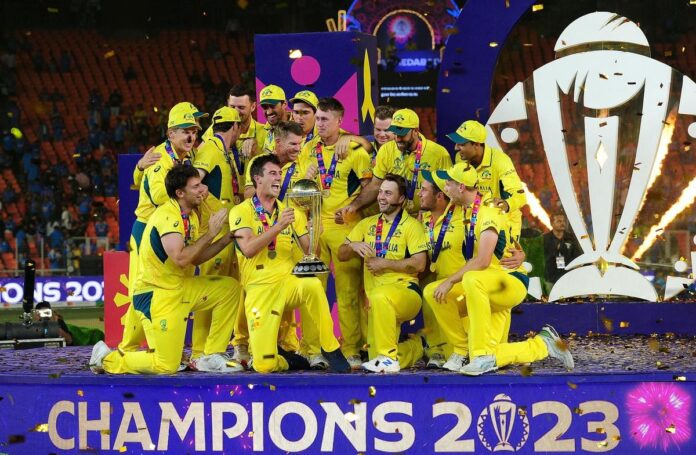By : Nitin P Gadkari
The curtains are drawn on the World Cup, but not before the drama played up at Narendra Modi Stadium, Ahmedabad. Post-match analysis is either euphoric or depressing, depending on whether you are writing from the winning or losing sides. I consider the diagnosis of such events far simpler than the prognosis. It is far easier to say what went wrong than how to avoid it. The Indian defeat at Ahmedabad would haunt the Indians of this generation as much as the last ball six of Chetan Sharma by Javed Miandad for the previous generation. There is one significant difference, however. The last generation was looking for a win out of defeats, and the current generation is looking at a defeat after a string of victories. Unlike the previous generation, it’s hard for this generation to take a loss.
I will not be surprised if the print, electronic, and online sources are full of reports regarding the ills of the BCCI: read Jay Shah, the BJP, the Dravid-Rohit nexus, the sitting out of Ashwin, the pitch, the toss and the predictions and many more such issues till the memory is tired of rereading the same and same thing. ‘Failure is an orphan, and success has many fathers’. I wish to put across a few theoretical perspectives which every avid watcher must be aware of whenever he sits down to discuss, predict or analyse. It is like a management lesson which must be a part of every cricketing campaign.
Cricket represents life, yet it is a game, and in a game, unlike in a war, one can lose or win; there is no shame in it. It is said that to be a good winner, one should first be a good loser. Nobody can beat the New Zealanders at it. They are the best side in this respect. They play with dignity, win with dignity, and lose with dignity. No one can forget how England beat New Zealand in the 2019 ICC World Cup. Every cricket fan had a tear for New Zealand that day. Was it true for India yesterday? I doubt many would say, ‘Good, get a taste of what you give’. I, for one, do not think that the Indian team deserves that comment. They played with dignity but lost without a proper plan, and I will come to that later.
Like in everything else, there is a law of averages in cricket. Simply said, if you toss a coin 100 times, there is a 50% probability of it falling ‘Head’ and 50% ‘Tails’. It might differ by a percentage or two, but increasing the sample size will get closer to 50%. If you don’t factor in the law of averages, one would be mocking God’s creation. For far too long, Rohit was winning the toss; he had a very good chance of losing it in the finals as he was up against Pat Cummings, who had lost the toss in the semifinals. Thus, the chances of India losing a vital toss in the finals were very bright. The law of averages covers practically every aspect of cricket. How often has one heard of a batsman scoring back-to-back three hundred in one international? Nil, yet people were banking on Virat Kohli to score one. It isn’t easy to get even a back-to-back-to-back hundred, and Shreyas Iyer made it big every time he came out to bat. He was a likely victim of the law of averages, as was KL Rahul. India’s chance of making a big score rested on the shoulders of Rohit, Shubhman, Surya Kumar Yadav, and Jadeja; the four had not got a big score coming into the finals. Rohit was partially successful, and others were not. Considering the law of averages may have given insight into which shot to play and which to avoid (This is a conjecture), yet in generic terms, it is true. Winning ten matches on the trot opens a team to the law of averages. Many would have heard from cricketing friends that India should lose at least one game going into the semifinals. It is sad if your winning streak takes a break, and it happens to be the finals. That is precisely what seems to have happened with India. This phenomenon would strike every team, irrespective of how good it is.
My final argument about the loss lies with the “It’s my Day” phenomenon. It was Australia’s Day on Sunday, 19th November 2023. Whatever they touched turned to gold. Pat Cummins won the toss, and Travis Head held that catch of Rohit Sharma reminiscent of Kapil’s catch of Viv Richards in 1983; Travis Head could have been out to Shammi in his second or third over when the ball narrowly missed the leg stump after an inside edge. On any other day, it would have hit the stump. Australian batsman mishits never reached anywhere close to the fielder. On the other hand, Shubhman’s first big attempt to hit the ball went straight to the fielder. Kohli’s first inside edge hit the stump. When it is your day, you get away with any mistake: read Murder. It was that sort of a day for Australia. These beliefs do not take away the credit that Australia deserves. It is a dream team with great fighters where all-rounders like Cameroon Green and Marcus Stonis have to sit on the reserve benches.
Coming to cricket proper. I believe India could not be faulted for how they played in the finals. Any other team would have been worse. If Australia were batting first, India would have been celebrating even as I write this 18 hours later. What I cannot understand, and that is where my cricket understanding conflicts with the happenings of the Sunday, is the strategy and planning for the finals. I, for one, feel the match was lost even before it started. Given the understanding of the probability of the outcome of the toss, it was a distinct possibility that India would lose the toss (explained earlier) and Australia could field first. Considering the dew was one of the factors, as admitted by the Australian captain at the toss. There was considerable dew on the previous evening. i.e. the evening of 18th November 2023. The pitch selected and prepared was distinctly dry and rough. It meant it would play slow and assist slow bowlers as long as the sun beat on it. If India were to bat first hypothetically, due to the probability of the toss, it would have been prudent to prepare a wicket which would remain consistent throughout the match. In cricket terms, a wicket which is watered better and rolled more. Such a wicket would have given equal advantage to both sides. Yet by preparing the wicket the way it was, the team batting first was doomed unless they got over 290 runs. Even Ravi Shastri’s pitch report before the toss echoed the same sentiment. This assessment is based on the premise that the team management had some tacit way of expressing a desire for the kind of wicket to be prepared. If yes, why would the team management take such a risk when playing with only five bowlers. Going by the result of the second innings, even seven bowlers would not have helped us, as the nature of the track changed so dramatically. Cricketing-wise, it’s a point to ponder. A remark by Rohit Sharma at the toss that we would have batted first even if we had won the toss signals either a lack of understanding of the Ahmedabad wicket or sheer overconfidence. Out of four matches played in the World Cup at the venue, three were won by the team batting second. Only one was lost, which was England to Australia. With such a track record and witnessing the lack of rolling off the wicket, to think of batting first was cricketing hara-kiri. The debate of playing five bowlers and not including Ashwin deserves a cricketing discussion, but the logic held good in ten matches, and the team management must have hoped it would hold good in the last match, too.
Yet all the above does not take away the incredible cricket the Indian team played over the last five weeks. They gave 1.3 billion Indians great moments of pride and joy, made the Navratri and Diwali special, gave a unifying reason to the nation and took away the mundane threads of conversations to something unique, discussing the nuances of cricket. In this World Cup, it did not matter who won or lost, as India won even when it lost.
Article Courtesy: Faugy Strategy article written by Nitin P Gadkari












